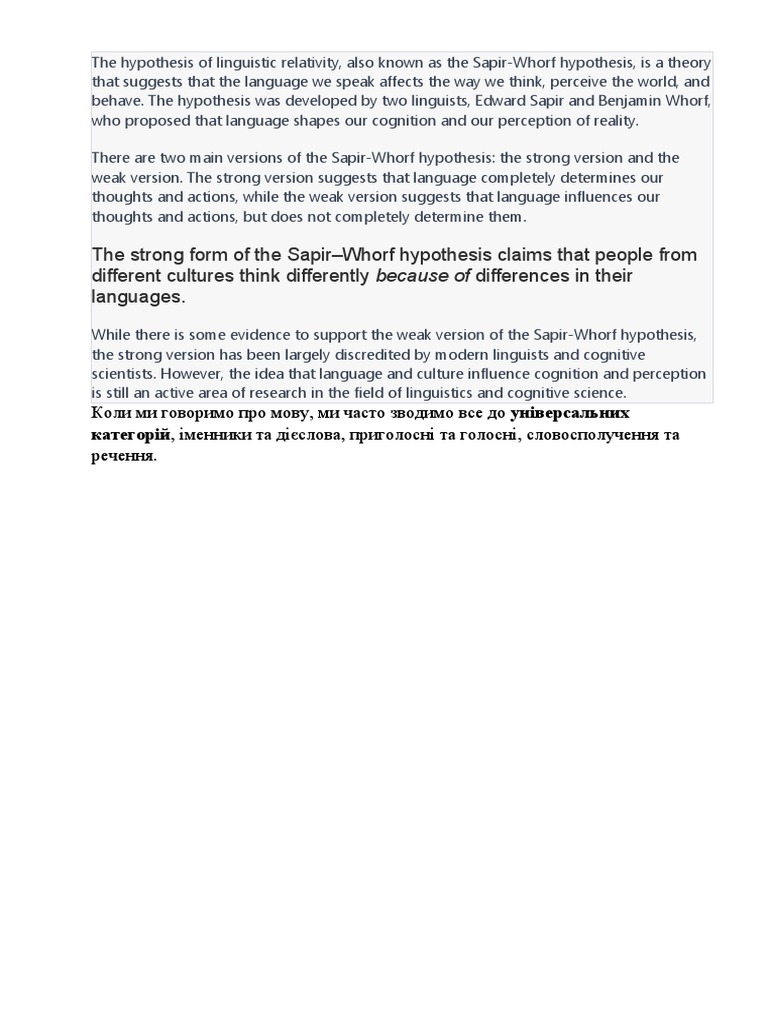The Sapir-Whorf hypothesis, often referred to as linguistic relativity, posits that the structure of a language can influence its speakers’ cognition and worldview. In essence, the language we speak can shape the way we perceive and categorize our experiences. One playful yet illustrative example involves how different cultures discuss color. Have you ever pondered how the nuances of color terminology might affect your perception of the world around you? Consider this: if a language has no word for “blue,” does this mean that its speakers perceive the sky differently than those who do?
To unpack this idea, let’s delve into the fascinating realm of color language. In English, we have a vast array of color descriptors, from azure to cerulean, indigo to navy. However, some languages, like the Himba tribe in Namibia, categorize colors quite differently. They might describe shades of green and blue with the same term, which could lead to a fascinating question: do they see the world in a fundamentally different way? Or is it that their experience of colors transcends our rigid categorizations?
Research has shown that speakers of different languages can indeed exhibit varying abilities to distinguish colors based on their linguistic frameworks. This phenomenon raises an intriguing challenge: if our language limits our ability to perceive certain colors, how might this extend to other domains of knowledge? Could we inadvertently be restricting our understanding of complex issues like climate change through the limitations of our environmental vocabulary?
Another playful suggestion pertains to how individuals from cultures with extensive terminology related to certain natural phenomena interpret ecological events. For instance, in certain Inuit languages, there are multiple words for snow, each describing different types and conditions. This linguistic abundance might enable speakers to experience the intricacies of their environment in a more nuanced way. Consider the impact of this on climate discussions: if a community is better equipped to describe and understand their changing environment, are they also more likely to engage in sustainable practices?
Visualize a scenario where two communities are confronted with similar environmental challenges, such as deforestation or rising sea levels. One community speaks a language rich in words for environmental changes, while the other lacks such linguistic variety. The community with a robust vocabulary may conceptualize their predicament in multifaceted ways, potentially leading to proactive measures and innovative solutions. In stark contrast, the less lexically endowed group may struggle to articulate their crisis and thus face challenges in mobilizing collective action.
This poses a contemplative challenge to educators and environmental advocates: how can we enrich our vocabulary around environmental issues to foster a sense of urgency and responsibility? By introducing terminology that captures the nuances of ecological interactions—such as “biodiversity,” “carbon footprint,” or “ecological footprint”—we empower individuals to convey their concerns more effectively and advocate for necessary change.
Moreover, consider the implications of the Sapir-Whorf hypothesis on activism. Language shapes reality. If advocates can weave their arguments with potent, evocative language, they can inspire action and galvanize support for climate initiatives. For instance, framing a discussion around “climate justice” rather than “climate change” emphasizes the moral dimensions of the crisis, encouraging deeper engagement and empathy.
As we explore this linguistic interconnection, let’s turn our attention to terminology surrounding renewable energy. Words such as “sustainability,” “clean energy,” and “green technology” resonate differently within various linguistic contexts. In societies where such terms are prevalent, the populace may possess a greater understanding and urgency toward adopting renewable practices. Conversely, communities lacking these specific terms may find sustainability more abstract and distant, which inevitably challenges their environmental consciousness.
Bringing this back to our initial playful question around color perception, one might ask: how does our environmental vocabulary affect our vision of the world? Are we, perhaps, like a community with a limited color palette, unable to visualize the vibrancy of a flourishing ecosystem? This evocative metaphor encourages us to broaden our linguistic horizon, fostering a collective understanding that extends beyond words.
In conclusion, the Sapir-Whorf hypothesis offers not just a theoretical framework but also an actionable challenge for nurturing environmental awareness and activism. Language possesses a unique power, shaping our thoughts, feelings, and actions toward the natural world. The more robust our environmental lexicon, the more capable we may become of understanding and interacting with our ecosystems. By developing a rich vocabulary that articulates our ecological concerns and aspirations, we pave the way for a future where we not only comprehend our environment but actively engage with it, fostering sustainability and resilience for generations to come. As we face unprecedented climate challenges, this linguistic exploration invites us to reassess our dialogues and fully embrace the breadth of our environmental legacy.
